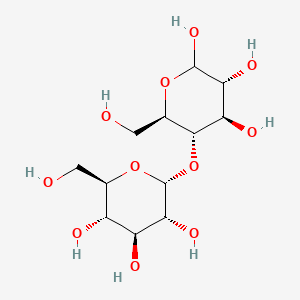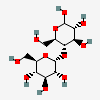Maltose
- maltose
- D-(+)-Maltose
- Malzzucker
- alpha-Malt sugar
- Cextromaltose
- Create:2005-06-24
- Modify:2025-01-18


- maltose
- D-(+)-Maltose
- Malzzucker
- alpha-Malt sugar
- Cextromaltose
- Maltobiose
- 4-(alpha-D-Glucosido)-D-glucose
- Malt sugar
- D-Maltose
- Advanctose 100
- alpha-D-Glcp-(1->4)-D-Glcp
- 4-O-alpha-D-glucopyranosyl-D-glucopyranose
- 16984-36-4
- Finetose
- Maltodiose
- Sunmalt
- 4-O-alpha-D-Glucopyranosyl-D-glucose
- Madoros (TN)
- Maltose (NF)
- 69-79-4
- Finetose F
- Sunmalt S
- Maltotetraose Deuterated
- alpha-D-glucopyranosyl-(1->4)-D-glucopyranose
- BRN 0093798
- alpha-D-glucopyranosyl-(1->4)-D-glucose
- 4-(alpha-D-Glucopyranosido)-alpha-glucopyranose
- (2R,3S,4S,5R,6R)-2-(hydroxymethyl)-6-[(2R,3S,4R,5R)-4,5,6-trihydroxy-2-(hydroxymethyl)oxan-3-yl]oxyoxane-3,4,5-triol
- Maltose, pure
- Maltose anhydrous
- CHEBI:17306
- 1-alpha-D-Glucopyranosyl-4-alpha-D-glucopyranose
- DTXSID101018093
- alpha-D-glucopyranose-(1->4)-D-glucopyranose
- Madoros
- Maltos
- AI3-09089
- Advantose 100
- Glca1-4Glcb
- Glcalpha1-4Glcbeta
- Martos-10
- GLUCOSE IMPURITY A (EP IMPURITY)
- GLUCOSE IMPURITY A [EP IMPURITY]
- Maltose [JAN]
- CHEBI:18167
- 4-O-a-D-Glucopyranosyl-D-glucose
- b-maltose
- DMaltose
- alpha-D-Glcp-(1->4)-beta-D-Glcp
- a-Malt sugar
- Martos10
- (2R,3S,4S,5R,6R)-2-(hydroxymethyl)-6-((2R,3S,4R,5R)-4,5,6-trihydroxy-2-(hydroxymethyl)oxan-3-yl)oxyoxane-3,4,5-triol
- O-a-D-glucopyranosyl-(1?4)-O-a-D-glucopyranosyl-(1?4)-O-a-D-glucopyranosyl-(1?4)-D-Glucose; Amylotetraose; a-1,4-Tetraglucose Deuterated
- ??-Lactose
- D(+)Maltose
- MALTOSE [VANDF]
- MALTOSE [INCI]
- MALTOSE [WHO-DD]
- 4(alphaDGlucosido)Dglucose
- bmse000017
- bmse000798
- bmse000946
- Epitope ID:140629
- SCHEMBL15065
- 4OalphaDGlucopyranosylDglucose
- 4-(a-D-Glucosido)-D-glucose
- DGlucose, 4OalphaDglucopyranosyl
- CHEBI:140774
- DTXCID901476324
- a-D-GLCP-(1->4)-D-GLCP
- a-D-GLCP-(1->4)-b-D-GLCP
- AKOS040758783
- 4OalphaDGlucopyranosylbetaDglucopyranose
- DB03323
- 4-O-a-D-Glucopyranosyl-D-glucopyranose
- 4(alphaDGlucopyranosido)alphaglucopyranose
- 4-O-a-D-Glucopyranosyl-b-D-glucopyranose
- AC-34685
- 1-a-D-Glucopyranosyl-4-a-D-glucopyranose
- 4-[(1->4)-alpha-D-glucosyl]n-D-glucose
- a-D-Glucopyranosyl-(1->4)-D-glucopyranose
- M0037
- NS00074109
- C00208
- D00044
- Q170002
- 4-O-.ALPHA.-D-GLUCOPYRANOSYL-D-GLUCOPYRANOSE
179.7 Ų [M+Na]+
181.9 Ų [M+K]+
204 999
147 993
217 654
361 545
205 417
147 999
204 983
361 864
103 799
217 581
145.04844 100
163.05945 71.30
85.02757 37.10
127.03915 28.90
97.02858 18.60
84.95734 100
204.80647 69.60
238.86613 50.50
192.85756 47.20
316.73853 44.90
343.111450 64
343.124512 59
343.116669 58
343.106201 47
313.067322 29
Information on 4 consumer products that contain Maltose in the following categories is provided:
• Personal Care
Not Classified
Reported as not meeting GHS hazard criteria by 188 of 189 companies (only 0.5% companies provided GHS information). For more detailed information, please visit ECHA C&L website.
Aggregated GHS information provided per 189 reports by companies from 3 notifications to the ECHA C&L Inventory.
Reported as not meeting GHS hazard criteria per 188 of 189 reports by companies. For more detailed information, please visit ECHA C&L website.
There is 1 notification provided by 1 of 189 reports by companies with hazard statement code(s).
Information may vary between notifications depending on impurities, additives, and other factors. The percentage value in parenthesis indicates the notified classification ratio from companies that provide hazard codes. Only hazard codes with percentage values above 10% are shown.
IMAP assessments - D-Glucose, 4-O-.alpha.-D-glucopyranosyl-: Human health tier I assessment
Evaluation - Chemicals that are unlikely to require further regulation to manage risks to environment
Patents are available for this chemical structure:
https://patentscope.wipo.int/search/en/result.jsf?inchikey=GUBGYTABKSRVRQ-PICCSMPSSA-N
- Australian Industrial Chemicals Introduction Scheme (AICIS)D-Glucose, 4-O-.alpha.-D-glucopyranosyl-https://services.industrialchemicals.gov.au/search-assessments/D-Glucose, 4-O-.alpha.-D-glucopyranosyl-https://services.industrialchemicals.gov.au/search-inventory/
- DrugBankLICENSECreative Common's Attribution-NonCommercial 4.0 International License (http://creativecommons.org/licenses/by-nc/4.0/legalcode)https://www.drugbank.ca/legal/terms_of_use
- EPA Chemicals under the TSCAD-Glucose, 4-O-.alpha.-D-glucopyranosyl-https://www.epa.gov/chemicals-under-tscaEPA TSCA Classificationhttps://www.epa.gov/tsca-inventory
- EPA DSSTox4-O-alpha-D-Glucopyranosyl-D-glucopyranosehttps://comptox.epa.gov/dashboard/DTXSID101018093CompTox Chemicals Dashboard Chemical Listshttps://comptox.epa.gov/dashboard/chemical-lists/
- European Chemicals Agency (ECHA)LICENSEUse of the information, documents and data from the ECHA website is subject to the terms and conditions of this Legal Notice, and subject to other binding limitations provided for under applicable law, the information, documents and data made available on the ECHA website may be reproduced, distributed and/or used, totally or in part, for non-commercial purposes provided that ECHA is acknowledged as the source: "Source: European Chemicals Agency, http://echa.europa.eu/". Such acknowledgement must be included in each copy of the material. ECHA permits and encourages organisations and individuals to create links to the ECHA website under the following cumulative conditions: Links can only be made to webpages that provide a link to the Legal Notice page.https://echa.europa.eu/web/guest/legal-noticeMaltose (EC: 200-716-5)https://echa.europa.eu/information-on-chemicals/cl-inventory-database/-/discli/details/57059
- International Fragrance Association (IFRA)LICENSE(c) The International Fragrance Association, 2007-2021. All rights reserved.https://ifrafragrance.org/links/copyrightD-Glucose, 4-O-α-D-glucopyranosyl-https://ifrafragrance.org/priorities/ingredients/ifra-transparency-list
- New Zealand Environmental Protection Authority (EPA)LICENSEThis work is licensed under the Creative Commons Attribution-ShareAlike 4.0 International licence.https://www.epa.govt.nz/about-this-site/general-copyright-statement/D-Glucose, 4-O-.alpha.-D-glucopyranosyl-https://www.epa.govt.nz/industry-areas/hazardous-substances/guidance-for-importers-and-manufacturers/hazardous-substances-databases/
- ChEBI
- E. coli Metabolome Database (ECMDB)
- LOTUS - the natural products occurrence databaseLICENSEThe code for LOTUS is released under the GNU General Public License v3.0.https://lotus.nprod.net/D-(+)-Maltosehttps://www.wikidata.org/wiki/Q170002LOTUS Treehttps://lotus.naturalproducts.net/
- Yeast Metabolome Database (YMDB)
- ClinicalTrials.govLICENSEThe ClinicalTrials.gov data carry an international copyright outside the United States and its Territories or Possessions. Some ClinicalTrials.gov data may be subject to the copyright of third parties; you should consult these entities for any additional terms of use.https://clinicaltrials.gov/ct2/about-site/terms-conditions#Use
- Consumer Product Information Database (CPID)LICENSECopyright (c) 2024 DeLima Associates. All rights reserved. Unless otherwise indicated, all materials from CPID are copyrighted by DeLima Associates. No part of these materials, either text or image may be used for any purpose other than for personal use. Therefore, reproduction, modification, storage in a retrieval system or retransmission, in any form or by any means, electronic, mechanical or otherwise, for reasons other than personal use, is strictly prohibited without prior written permission.https://www.whatsinproducts.com/contents/view/1/6Consumer Products Category Classificationhttps://www.whatsinproducts.com/
- Cosmetic Ingredient Review (CIR)
- Haz-Map, Information on Hazardous Chemicals and Occupational DiseasesLICENSECopyright (c) 2022 Haz-Map(R). All rights reserved. Unless otherwise indicated, all materials from Haz-Map are copyrighted by Haz-Map(R). No part of these materials, either text or image may be used for any purpose other than for personal use. Therefore, reproduction, modification, storage in a retrieval system or retransmission, in any form or by any means, electronic, mechanical or otherwise, for reasons other than personal use, is strictly prohibited without prior written permission.https://haz-map.com/About
- NORMAN Suspect List ExchangeLICENSEData: CC-BY 4.0; Code (hosted by ECI, LCSB): Artistic-2.0https://creativecommons.org/licenses/by/4.0/D-(+)-MaltoseNORMAN Suspect List Exchange Classificationhttps://www.norman-network.com/nds/SLE/
- Natural Product Activity and Species Source (NPASS)
- West Coast Metabolomics Center-UC DavisMaltose
- FDA Substances Added to FoodLICENSEUnless otherwise noted, the contents of the FDA website (www.fda.gov), both text and graphics, are not copyrighted. They are in the public domain and may be republished, reprinted and otherwise used freely by anyone without the need to obtain permission from FDA. Credit to the U.S. Food and Drug Administration as the source is appreciated but not required.https://www.fda.gov/about-fda/about-website/website-policies#linking
- FooDBLICENSEFooDB is offered to the public as a freely available resource. Use and re-distribution of the data, in whole or in part, for commercial purposes requires explicit permission of the authors and explicit acknowledgment of the source material (FooDB) and the original publication.https://foodb.ca/about
- Japan Chemical Substance Dictionary (Nikkaji)
- KEGGLICENSEAcademic users may freely use the KEGG website. Non-academic use of KEGG generally requires a commercial licensehttps://www.kegg.jp/kegg/legal.htmlCompounds with biological roleshttp://www.genome.jp/kegg-bin/get_htext?br08001.keg
- MassBank Europe
- MassBank of North America (MoNA)LICENSEThe content of the MoNA database is licensed under CC BY 4.0.https://mona.fiehnlab.ucdavis.edu/documentation/license
- Metabolomics Workbench
- NCI Thesaurus (NCIt)LICENSEUnless otherwise indicated, all text within NCI products is free of copyright and may be reused without our permission. Credit the National Cancer Institute as the source.https://www.cancer.gov/policies/copyright-reuse
- NLM RxNorm TerminologyLICENSEThe RxNorm Terminology is created by the National Library of Medicine (NLM) and is in the public domain and may be republished, reprinted and otherwise used freely by anyone without the need to obtain permission from NLM. Credit to the U.S. National Library of Medicine as the source is appreciated but not required. The full RxNorm dataset requires a free license.https://www.nlm.nih.gov/research/umls/rxnorm/docs/termsofservice.html
- Rhea - Annotated Reactions DatabaseLICENSERhea has chosen to apply the Creative Commons Attribution License (http://creativecommons.org/licenses/by/4.0/). This means that you are free to copy, distribute, display and make commercial use of the database in all legislations, provided you credit (cite) Rhea.https://www.rhea-db.org/help/license-disclaimer
- Springer Nature
- Thieme ChemistryLICENSEThe Thieme Chemistry contribution within PubChem is provided under a CC-BY-NC-ND 4.0 license, unless otherwise stated.https://creativecommons.org/licenses/by-nc-nd/4.0/
- Wikidata
- Wikipedia
- Wiley
- Medical Subject Headings (MeSH)LICENSEWorks produced by the U.S. government are not subject to copyright protection in the United States. Any such works found on National Library of Medicine (NLM) Web sites may be freely used or reproduced without permission in the U.S.https://www.nlm.nih.gov/copyright.htmlSweetening Agentshttps://www.ncbi.nlm.nih.gov/mesh/68013549
- PubChem
- GHS Classification (UNECE)GHS Classification Treehttp://www.unece.org/trans/danger/publi/ghs/ghs_welcome_e.html
- Glycan Naming and Subsumption Ontology (GNOme)GNOme
- MolGenieMolGenie Organic Chemistry Ontologyhttps://github.com/MolGenie/ontology/
- PATENTSCOPE (WIPO)SID 403029544https://pubchem.ncbi.nlm.nih.gov/substance/403029544







